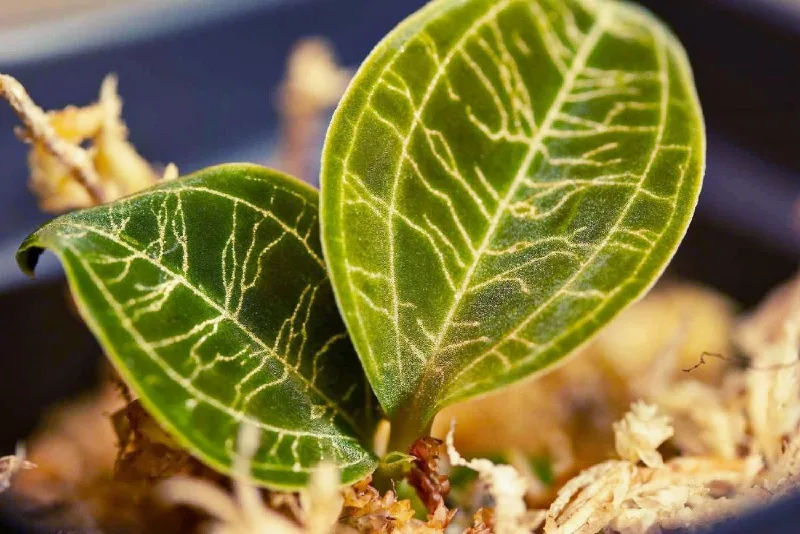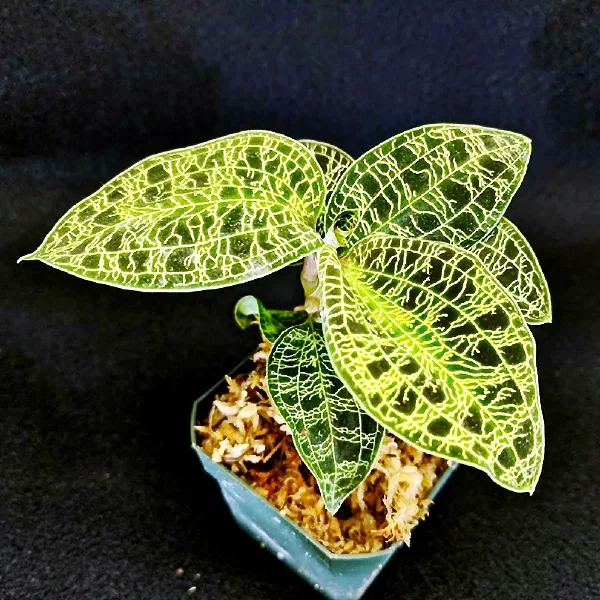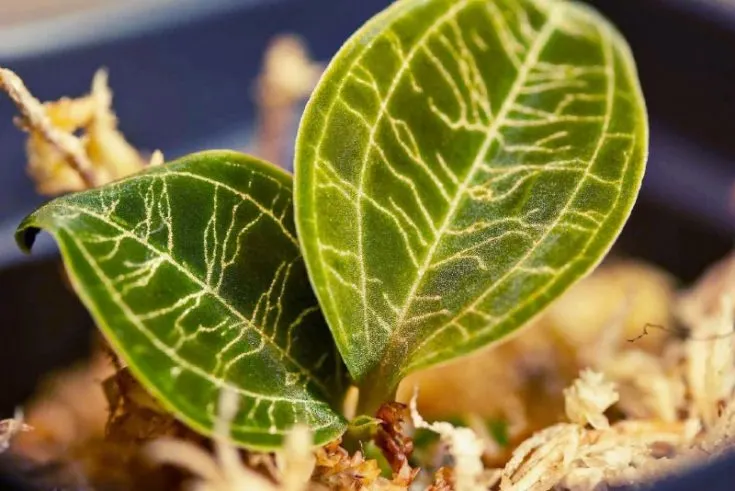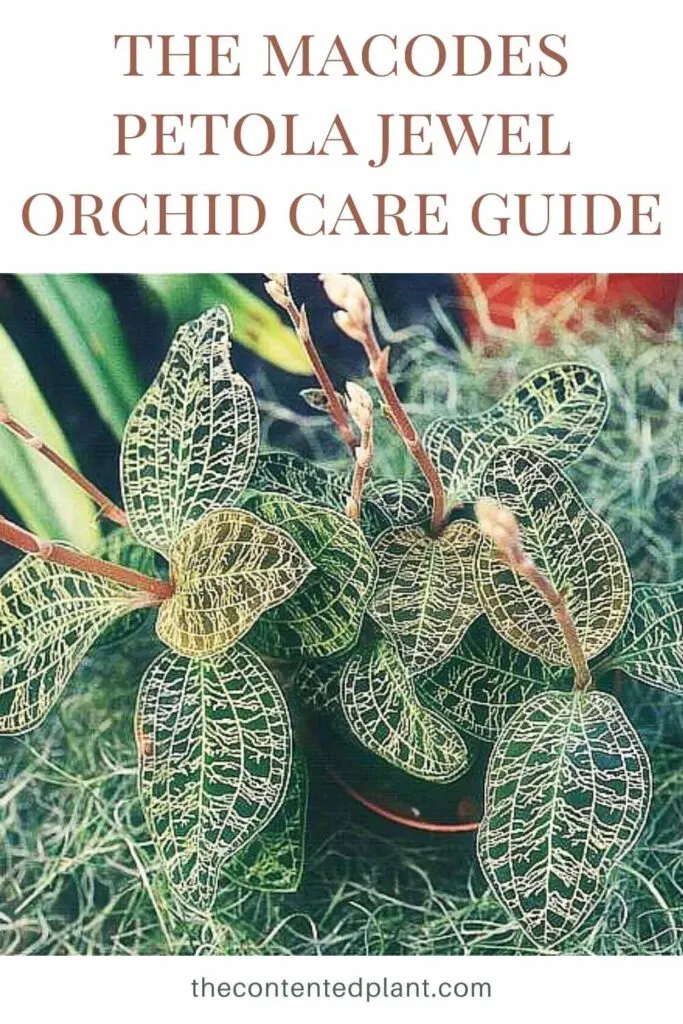Jewel Orchids offer a very attractive but wildly different variety of Orchid for the houseplant hobbyist. This jewel variety, the Macodes petola, has stunning foliage and low growing habits.
All Jewel orchids are terrestrial orchids rather than an epiphyte like Phalaenopsis. They are native to Southeast Asia. Since these plants are good herbal stimulants they have been over collected in the wild. Choose Nursery clones rather than wild grown stock to preserve this species.
The Macodes does flower. However its flowers are rather small and insignificant. More like peperomias rather than the large showy colorful moth orchid flowers. If you want showy flowers go with the moth orchids.
Macodes petola orchids have very different care needs than epiphytic orchids. These aroid plants grow on the forest floor in nature. They ramble around on the ground but stay on the ground..
Macodes roots need air but cannot be dry. Rather like the rain forest understory Calatheas plants. If you can grow a calathea or Alocasia Polly successfully, you have a good chance of success with the Jewel orchids.
The Lightning Bolt Jewel Orchid:
Macodes petola is also known as the lightning bolt orchid.

This plant has a very interesting leaf veining pattern. An intense lightning bolt pattern runs throughout the leaf surface.
The leaves are thick and velvety. This adds depth and warmth to the plant. And increases the “lightning bolt in the night” ambience.
Even More exciting is the visual effect of the veining. The leaf vein colors actually reflect light. They shimmer as the light moves. This creates a truly electrical effect if you move the leaves under light. Quite a stunner!

Jewel Orchids are Air Purifying Plant:
All orchids are known to absorb carbon dioxide and remove xylene from the air. They actually create oxygen at night. Put them in your bedroom for a better nights sleep.
Jewel Orchid Terrarium Growing:
Macodes Petola is sometimes considered a good terrarium plant. It loves humidity. If you live in a very dry climate this may be a good option. But be careful.
The Lightning orchid loves humidity and stagnant air since they are tropical rainforest plants. The ROOTS, however, will not tolerate being saturated. The Roots need to be grown in an airy light well draining soil.
Look at this video by Michikusa to see how he puts together a terrarium for the Macodes Petola.
Orchid root rot is a real concern in growing this plant in an airless terrarium. All aroid plants like the jewel orchids are susceptible to root rot when grown in incorrect conditions.
Also remember viruses and molds LOVE moist warm, stagnant conditions too. Use sterile tools and make sure your orchid is free of mold and viruses on the leaves before planting it in a terrarium.
Shop Jewel Orchids On Etsy

Non toxic Plant:
All orchids are Non toxic to pets and people.
Macodes Petola Care:
The proper soil for the conditions any plant is grown in is vital. And you will have to know your home environment to adjust the soil, light and humidity.
Lightning bolt orchids grow best when the roots are moist but NOT wet, have the proper soil for conditions and the leaves are able to absorb and respire moisture in the proper amounts.
Can you grow these plants successfully in lower humidity home? Probably, if you know how to balance conditions and add humidity as needed.
We give you lots of tips on how to do this in our printable plant care guide below.
Macodes Petola Jewel Orchid Care Guide

Macodes Petola is one of the jewel orchids. Jewel orchids are aroids rather than epiphytes like their relatives like the Phalaenopsis.
Macodes live on the ground in soil and have some very different care instructions from epiphytic orchids.
Read our complete care guide to learn how to grow these pretty plants.
Tools
Instructions
Proper Soil Mix:
- Jewel Orchids prefer well draining aroid potting mix. The roots will rot quickly if they sit in dense, heavy, wet soil.
These Orchids need a Bromeliad or aroid potting mix. linked in materials above. They are available on both Amazon and Etsy. - Pebbles or Leca balls in the bottom of your pot will further help with areation and drainage.
Pot Size and Type:
- Well draining pots allow the Macode Petola roots to breathe.
- Repot every second year or when roots come out of the pot.
- Don't jump to a huge pot from a small one. Just go to the next size up pot. Too large a pot encourages root rot.
Lighting needs:
- Give this plant low to moderate INDIRECT light at least 6 hours a day. Bright indirect light is fine but NOT direct strong light.
- In nature these are understory plants. They cannot tolerate strong direct light.
- If you have a very low light index in winter (think Seattle), a supplemental grow light may help keep your plant healthy.
How to Water a Jewel Orchid:
- Jewel Orchids do NOT tolerate over watering. When properly potted in an aroid mix they need watering when the soil is almost dry.
- Do NOT allow the plant to completely dry out. The roots must have continous moisture and lots of oxygen around the roots.
- Use the moisture meter to determine if the roots need water.
- In the growing season and brighter light you may need to water more than once a week but don't over do it.
- In dormant winter months reduce watering to when the soil is ALMOST completely dry.
- Never let this plant get soggy wet feet. Orchids in heavy wet soils get root rot and fungus gnats.
Humidity Tips:
- Jewel Orchids love humid conditions. Keep them at 40 to 60% humidity for best conditions. Live in a dry area? Here are some ideas on how to get humidity higher for your plant.
- Use a hygrometer to determine your humidity in the vacinity of your plant. This will help you know when the humidity is out of there preferred range.
- Pebble Trays: set a tray or deep plate (1/2 to an inch) full of pebbles under your macode petola. Pour water into the tray and keep it not quite full of water. Just under the top of the pebbles.
- Group your plants close together (watch out for pest hitchhikers). Plant respire. So when you place them close together they increase the humidity.
- humidifiers: Use these as needed if you cannot get the humidity up and your plant leaves are browning along the edges and looking dehydated (thin and curling)
- For this plant in particular add spagnum moss aound the top of the soil and keep it slightly moist so it can evaporate up into the plant.
Fertilizing Jewel Orchids:
- Apply a good quality Orchid fertilizer (linked in materials) monthly through Spring and summer.
Alternately, you can fertilize weekly if you use quarter strength orchid fertilizer. This gives the plant more consistent feeding over a month. - Decrease feedings by late Fall and allow your orchid to rest through the winter months.
Orchid Temperature:
- Orchid plants vary in their temperature preferences.
The orchids will do best in temperatures between 65-85 degrees F.
Pests:
- Unfortunately, jewel orchids are susceptible to a number of insect and mite pests, including aphids, mealybugs, scales, spider mites, and thrips.
Stress by longterm overwatering, poor light, extreme temperatures and soil conditions are contributors to plant susceptibility to pest infestations..
To minimize the possibility of pests be sure to check all nursery plants before bringing them home.
Quarantine all new plants until you are sure no pests live in them
Notes
Terrarium Growing:
Macodes is sometimes considered a good terrarium plant. It loves humidity. If you live in a very dry climate this may be a good option. But be careful.
The Lightning bolt jewel orchid loves humidity and stagnant air since they are a tropical rainforest plant. The ROOTS, however, will not tolerate being saturated. The Roots need to be grown in an airy light well draining soil.
Look at this video by Michikusa to see how he puts together a terrarium for the Mocodes Petola.
Problems with Terraiums:
Orchid root rot is a real concern in growing this plant in an airless terrarium. All aroid plants like the jewel orchids are susceptible to root rot when grown in wet conditions.Be sure to pay particular attention to the moisture around the roots. Be sure to use a good substrate for this plant.
Also remember viruses and molds LOVE moist warm, stagnant conditions too. Use sterile tools and make sure your orchid is free of mold and viruses on the leaves before planting it in a terrarium.
Video Notes:
The Jewel Orchids need an aroid soil mix rather than the Pure Orchid bark Kayte is using in this video. Also they do not require a special orchid pot. Any well draining pot will be fine.
Related Content:
Follow Us:
Find us on YouTube, Instagram , Pinterest and TikTok! We love to Plant chat. We also comment, like and occasionally share your content to our daily stories. We’d love to see your plants. Share your joy in your houseplants. Happy Planting!
Recent Post from the Contented Plant:

